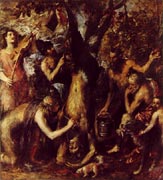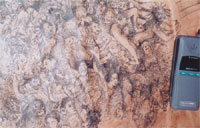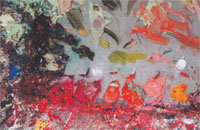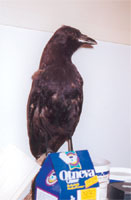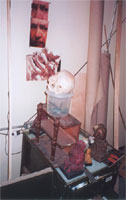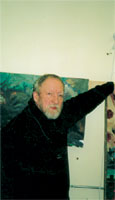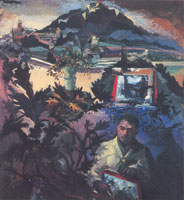"A very normal guy" Robert
Barnes on Marcel Duchamp and Étant Donnés
Tout-Fait: There are some historic figures that you refer to in your paintings. Robert Barnes: There is Joyce, Tzara, Stieglitz (18). I really admired Tzara, he reminded me of myself when I was younger. Tout-Fait: Did you meet him? Robert Barnes: Once at a thing. It was way towards the end of his life, I think the last year of his life. I don't remember when he died, in the '60s. And he said that he thought the last bastion of an icon class was a conservative state. Tout-Fait: And that's where we are?
Robert Barnes: No I don't think that's where we are, but I think that if you want something shocking anymore, it might have to be very conservative. Maybe that's why we elected that guy with the tiny little (Fig. 29). Things flip back and forth. We've experienced so much license. I love license, I love not being under control. But we've experienced so much of it that it gets jaded. I mean, sex, sex is boring to kids. I always thought it was my daughters whom I should prohibit having sex and tell them that they can't do this and it's terrible so that they'd enjoy it. I thought holding hands was exciting when I was kid, now fucking is about that level, so where do you go up? Maybe killing people or something. Tout-Fait: That's true. There's also a big movement of women who want to stay virgins until they get married. Robert Barnes: Heh, try it. Tout-Fait: You put yourself in a very interesting position of course where people will come knock on your door. Robert Barnes: I have no objection to the drama and distance that people go through to get attention with their so-called works of art, except that they are getting known and I don't like it. I don't like getting known to art, particularly. Tout-Fait: In a way, since there are no more movements... Robert Barnes: Do you know what killed the movements? When someone decided to call the last movement that we heard of Neo-Geo. Even the yuppies laughed when you uttered that one, they did try Neo-romanticism after that. That was so pathetic. Tout-Fait: Well because there is a lot of individuality going on, I think that in order to be an artist you also have to have social skills, to be a socializer, you know, schmoozing up to the right people and all to get exposure so that you will win a gallery show. Now it's not in the hand of artists anymore. In a way it is tough to get back from there. Robert Barnes: You know, Dada thought that they were anti-art. The social extremes of art is what really created an anti-art atmosphere and at a certain point it got exciting to see something that wasn't trying to bop you. But I don't know if we can go back to a state where we enter into something that is coming at us. And you know I always thought that the worst thing that happened - and I really didn't discourage my children from it - was Sesame Street. Everyone raised their hands and said "Isn't that wonderful, our children are learning the alphabet." They are being shrieked at by purple animals and then at a certain point school started to entertain the students. I mean I ran into that in college. The best professors, the ones that are really given the awards, were the ones that were very eccentric, entertainers, and that's nuts. Tout-Fait: The entertainment thing is very American. That you have to entertain. Robert Barnes: What it does is it closes you out of the act. It makes you victim of the act but it closes you out of the experience. All of your experience is sensation and you're not allowed to move in. When I'm in Italy, I love to go see some of these Renaissance paintings that you can't leave. You have to stay in those paintings; you can't just say "look I'm shocked" and then go on. No, you look and you wonder. Tout-Fait: That has already started with the reproduction of images in catalogues since the early 20th century. You are conditioned. You flip through them and you can look at all of this stuff very fast and no one is really strained, it is not demanded of you and you are not trained to appreciate art by looking at it for a very long time. Or by making that effort because you think that everything should be fast and then move on. Robert Barnes: Well I'm not complaining. I think it's good and that if it does destroy art as a thing, art as a possession or a commodity, then that is fine. We will start at another level and find something else. Tout-Fait: Can you repeat the story about the turtle again that's been sitting on your lap since the beginning of our interview? Robert Barnes: There's a guy in Michigan. I used to buy stuffed animals, taxidermy. He's a master. I mean this turtle is beautiful, it even has mud on his back. It's just a gorgeous piece of art, this thing. And he was a master, I mean I went up there and he was stuffing a polar bear. Tout-Fait: You needed these for your art basically? Robert Barnes: Yeah I like them around. My wife paints still-lives with them in it and I just like them to be here. Maybe it's because they're not supposed to be here. Well I would call him and he would sell me things that people would pay him a deposit to do and never come back for them. So I would pay the other part of the fee and they were cheap, like thirteen, fifteen dollars. So all of the sudden I tried calling and I could not get through and finally I checked up and called information and, I guess it can be told now, this guy tells me, "we had his phone tapped for a year." Turns out he had been stuffing his animals with dope. A great way when you think of it. Who is going to suspect? If this turtle here is full of cocaine that would be very nice. I still don't think I would open it up because it is too beautiful. Tout-Fait: Is that the place where you got the pigskin? Robert Barnes: No, no this was much later. Tout-Fait: Do you remember the place where you got the pigskin? Robert Barnes: I think it was in Trenton. Tout-Fait: In Trenton, where he supposedly got the urinal. Robert Barnes: Trenton's a great place. Tout-Fait: Was that a meat place? Robert Barnes: A butcher. I didn't know the urinal came from there. Trenton might be an art center. Did you ever think of that? Tout-Fait: That was where the Trenton Pottery was, where Duchamp's Mutt-urinal was supposedly made. Robert Barnes: You see it's an art center. Tout-Fait: Why go to a butcher in Trenton if there are so many in New York? Robert Barnes: Because no one would do it. Can you get pigskin off without wrecking it? Tout-Fait: No, but that butcher could?
Robert Barnes: I guess so. I live in this country village in Italy and the guy that butchers pigs every year asked me "Roberto, I want you to help me with the slaughter tomorrow." And I said, "Vittorio, I'm a painter, not really a butcher." And he said, "I have to get up at four in the morning. I want to be with someone who is a good conversationalist. I'll show you how to kill pigs." And he did. If you knew what was inside of pigs, you wouldn't eat them. It was awful stuff. But it was interesting and that's what got me started to do paintings about the Flaying of Marsyas (Fig. 30) (19), it means the removal of the external self in the Renaissance and I always liked the idea of peeling away layers. The painting came much later so I must have had the Duchampian idea on my mind of peeling away a skin and putting it somewhere else. People used to dress and masquerade in skins sometimes, not just furs, but sometimes other people's skins. Anyway, the Italian butcher had me killing these pigs and it really is a shocking experience. Pigs are very human and it is very much like a human sacrifice. I did a lot of Flaying of Marsyas paintings after that. I never did a pig, but it is an act that you don't forget. Tout-Fait: You're not happy with pop art? Robert Barnes: Well why, I'm not unhappy either. Tout-Fait: While we took our stroll through the Bloomington Art Museum you looked at certain paintings and said "Oh my God." Robert Barnes: Well I remember I had kids books "look at the spot" and then you'd look away and see a spot, so what? You know what we've done over the last hundred years? We have dissected the work of art. You have optical art, which is the visual, you have abstract expression, which was so involved with the touch, and I still love that. That's probably why I don't do other things because I love the feel of paint, very sensual, very sexual. Tout-Fait: Touch is something you are never allowed to do in museums. Robert Barnes: Museums are another story. They are mortuaries. You have abstract expression, which deals with surface, optical art, which is the effects of light and dark, of colors, you have pop art, which deals with subject matter. Basically the idea and sensation of the image left behind tactility and in some cases the optical effect of color. Duchamp represented the bigger idea of art as an idea or idea as the gas, motivated by the gas of the people, and that is probably the best of the bunch. If you keep dissecting, even conceptual art is just the idea. I always think that conceptual art grew out of the academic. Tout-Fait: Conceptual art owes to Duchamp as well. Robert Barnes: Yeah but see Duchamp appealed to the academics because he was an intellectual. Not that they ever understood it or ever would or could or should, but it was an intellectual act, so they had to distort it. The revenge, the way academics wreck art is by explaining it. It's the most obscene thing you do. And look at the books on Marcel, thousands of books on Marcel, all of them falling over each other to explain. The best would be a book that is so absurd that it becomes another work, almost a readymade or some absurdity. But at any rate, I think that the conceptual art grew out of the academics, explaining so much that they finally did the ultimate thing, got rid of the act of art or work and had only the explanation of it. That's fine, terrific, but I don't like the pieces. Tout-Fait: The only thing Duchamp wasn't was political. Robert Barnes: I never heard him say anything… political in what way? Tout-Fait: Well, all of his known remarks on politics and world affairs probably do not exceed five hundred words. Robert Barnes: Don't you ever think that is the artist's posture? Tout-Fait: Well I would think that you would be a little bit more concerned about both world wars, nuclear bombs, and even the student riots in 1968.
Robert Barnes: If you look at it, Picasso (20) was very artificial in terms of his political acts, even the communist party was so inept that he didn't like it. Tout-Fait: Well Guernica (Fig. 31) was always… Robert Barnes: Well I'm not sure that that was even a factor, it didn't certainly stop anything. Politics and art. Politics is always pathetic when it gets involved in art. Tout-Fait: Well the other way around, you just talked about being the bard, being able to stop the war. Robert Barnes: Well we can't do that anymore. Walking onto the battlefield is a little easier than having missiles shot at you. I think that the political posture is almost designed for the artist. It's pathetic. I like to shock people by saying that war is probably the ultimate work of art, so ultimate that, if you don't do it well, you get killed. Artists are always talking about how hard it is to be an artist or make works or how painful… War is really horrible, painful, and if you do make a mistake, you don't get a chance to erase it or wipe it off a canvas. I always think artists are such ninnies. I mean we can change everything and in a sense that is good but if you run over somebody on the street, you can't back up and have them come back to life. In painting, if you make a mistake or everything goes wrong, you can wipe it off. Tout-Fait: Because they're suffering so much without actually experiencing… Robert Barnes: There's no suffering involved in a work of art. But maybe realizing that you're stupid is suffering. Tout-Fait: So a lot more people are involved in the arts that probably should be doing something else. Robert Barnes: Well 99% probably. That's why they teach.
Notes
|
|||||||||||||||||||||||||||||||

